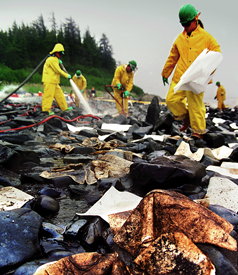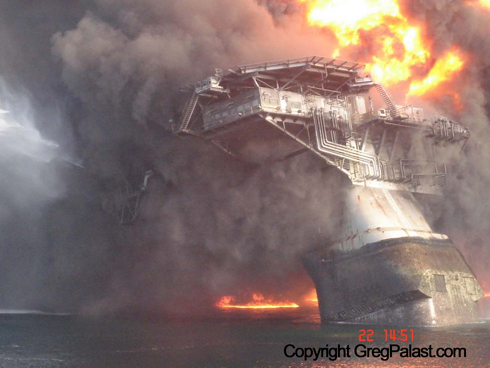
by Greg Palast
 I've seen this movie before. In 1989, I was a fraud investigator hired to dig into the cause of the Exxon Valdez disaster. Despite Exxon's name on that boat, I found the party most to blame for the destruction was ... British Petroleum (BP).
I've seen this movie before. In 1989, I was a fraud investigator hired to dig into the cause of the Exxon Valdez disaster. Despite Exxon's name on that boat, I found the party most to blame for the destruction was ... British Petroleum (BP).
That's important to know, because the way BP caused devastation in Alaska is exactly the way BP is now sliming the entire Gulf Coast.
Tankers run aground, wells blow out, pipes burst. It shouldn't happen, but it does. And when it does, the name of the game is containment. Both in Alaska, when the Exxon Valdez grounded, and in the Gulf last week, when the Deepwater Horizon platform blew, it was British Petroleum that was charged with carrying out the Oil Spill Response Plans (OSRP), which the company itself drafted and filed with the government.

What's so insane, when I look over that sickening slick moving toward the Delta, is that containing spilled oil is really quite simple and easy. And from my investigation, BP has figured out a very low-cost way to prepare for this task: BP lies. BP prevaricates, BP fabricates and BP obfuscates.
That's because responding to a spill may be easy and simple, but not at all cheap. And BP is cheap. Deadly cheap.
To contain a spill, the main thing you need is a lot of rubber, long skirts of it called a "boom." Quickly surround a spill, leak or burst, then pump it out into skimmers, or disperse it, sink it or burn it. Simple.
But there's one thing about the rubber skirts: you've got to have lots of them at the ready, with crews on standby in helicopters and on containment barges ready to roll. They have to be in place round the clock, all the time, just like a fire department, even when all is operating A-O.K. Because rapid response is the key. In Alaska, that was BP's job, as principal owner of the pipeline consortium Alyeska. It is, as well, BP's job in the Gulf, as principal lessee of the deepwater oil concession.
Before the Exxon Valdez grounding, BP's Alyeska group claimed it had these full-time, oil spill response crews. Alyeska had hired Alaskan natives, trained them to drop from helicopters into the freezing water and set booms in case of emergency. Alyeska also certified in writing that a containment barge with equipment was within five hours sailing of any point in the Prince William Sound. Alyeska also told the state and federal government it had plenty of boom and equipment cached on Bligh Island.
But it was all a lie. On that March night in 1989 when the Exxon Valdez hit Bligh Reef in the Prince William Sound, the BP group had, in fact, not a lick of boom there. And Alyeska had fired the natives who had manned the full-time response teams, replacing them with phantom crews, lists of untrained employees with no idea how to control a spill. And that containment barge at the ready was, in fact, laid up in a drydock in Cordova, locked under ice, 12 hours away.
As a result, the oil from the Exxon Valdez, which could have and should have been contained around the ship, spread out in a sludge tide that wrecked 1,200 miles of shoreline.
And here we go again. Valdez goes Cajun.
http://www.truthout.org/slick-operator-the-bp-ive-known-too-well59178








No comments:
Post a Comment